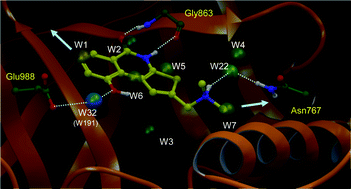Discovery and characterization of novel potent PARP-1 inhibitors endowed with neuroprotective properties: From TIQ-A to HYDAMTIQ†
Abstract

* Corresponding authors
a
Dipartimento di Chimica e Tecnologia del Farmaco, Università di Perugia, Via del Liceo 1, Perugia, Italy
E-mail:
rp@unipg.it
Fax: +39 075 5855124
Tel: +39 075 5855120
b Pfizer Global Research and Development, Neuroscience Research Unit, 558 Eastern Point Road, Groton, CT, USA
c Dipartimento di Farmacologia Preclinica e Clinica, Università di Firenze, V.le Pieraccini 6, Firenze, Italy
d Dipartimento Farmaceutico, Università di Parma, V.le G.P. Usberti 27/A, Parma, Italy
e Pfizer Global Research and Development, Global Biotherapeutic Technologies, 200 Cambridgepark Drive, Cambridge, MA

 Please wait while we load your content...
Something went wrong. Try again?
Please wait while we load your content...
Something went wrong. Try again?
R. Pellicciari, E. Camaioni, A. M. Gilbert, A. Macchiarulo, J. A. Bikker, F. Shah, J. Bard, G. Costantino, A. Gioiello, G. M. Robertson, P. Sabbatini, F. Venturoni, P. Liscio, A. Carotti, D. Bellocchi, A. Cozzi, A. Wood, C. Gonzales, M. M. Zaleska, J. W. Ellingboe and F. Moroni, Med. Chem. Commun., 2011, 2, 559 DOI: 10.1039/C1MD00021G
To request permission to reproduce material from this article, please go to the Copyright Clearance Center request page.
If you are an author contributing to an RSC publication, you do not need to request permission provided correct acknowledgement is given.
If you are the author of this article, you do not need to request permission to reproduce figures and diagrams provided correct acknowledgement is given. If you want to reproduce the whole article in a third-party publication (excluding your thesis/dissertation for which permission is not required) please go to the Copyright Clearance Center request page.
Read more about how to correctly acknowledge RSC content.
 Fetching data from CrossRef.
Fetching data from CrossRef.
This may take some time to load.
Loading related content
